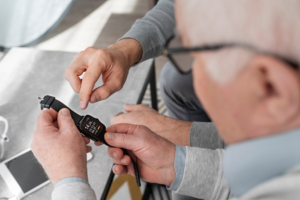
It’s a frightening experience to receive an unexpected call, or worse, not receive a call when you expect one. Imagine this: An adult daughter is at work when she receives an alert on her phone. Her 82-year-old father, who lives alone, has fallen. The relief comes swiftly – thanks to his personal alarm, help was dispatched within minutes, and she was immediately informed. These stories are becoming increasingly common and, frankly, necessary.
As we live longer, it’s important to consider how we ensure our loved ones are safe and secure as they navigate their golden years. For reliable and comprehensive information on alarms for seniors, explore Life Assure.
As the senior population grows, so does the need for smart, reliable safety solutions. Local families, right here in Springfield, are increasingly turning to personal alarms. It’s a modern approach to an age-old concern: keeping our elders safe, secure, and independent. This article will delve into the rising need for these solutions, explore what personal alarms are and how they work, highlight key features families are looking for, gather insights from healthcare professionals, provide a market overview of available options, and ultimately show how these devices are bringing peace of mind to so many families.
The Growing Concern: Keeping Our Elders Safe
It’s no secret that we’re seeing a boom in the senior population. People are living longer, healthier lives. But that also means more seniors are living alone, and with that comes increased risks. We’re talking about falls, medical emergencies, even memory loss or wandering. The statistics don’t lie; elder-related accidents are on the rise. And delayed responses to these incidents can have devastating consequences.
This puts a huge emotional and logistical strain on family caregivers, especially adult children who are juggling their own careers and families. The worry is constant. The good news is, there’s a growing interest in technology-enabled aging-in-place tools, and families are looking for solutions that allow their loved ones to maintain their independence while providing a safety net. Personal alarms are a big part of that, providing comfort and safety for you and your elders. Someone once said they’re worth their weight in gold.
What Personal Alarms Are and How They Work
So, what exactly are personal alarms? Simply put, they’re wearable or stationary devices designed to signal for help in an emergency. Think of them as a direct line to assistance when it’s needed most. The types of alarms vary to provide for the specific and individual needs of different people.
There are wearable pendants, bracelets, and even smartwatches – the most popular and readily accessible options. These are great because they’re always on hand, accessible in any room or even outside the house. Then there are stationary devices, often placed near the bed or in the bathroom, that can be easily activated in case of a fall or other emergencies.
Some even offer voice-activated assistants, like Alexa or Google Home, that seniors can use to call for help hands-free, which can be really helpful for those with limited mobility. And for the more active seniors, there are GPS-enabled devices that will track their location, which is particularly useful for those with memory issues and are at risk of wandering.
How do they work? It’s actually quite simple. When the alarm is activated, it connects to a call center, which can then dispatch emergency services or alert pre-programmed emergency contacts.
GPS tracking allows responders to pinpoint the user’s location, and some alarms even have two-way communication, so the user can speak directly to the call center. Of course, there are pros and cons to each type. Wearable devices are convenient but may require charging. Stationary devices are reliable but limited to a specific location. But, ultimately, the goal is the same: to provide a quick and easy way to summon help when it’s needed most.
What to Look for: Key Features in Personal Alarms
When you are looking into these options, there are a few essential features you’ll want to keep in mind:
- Emergency Response Time: This is crucial. How quickly will the alarm connect to a call center or emergency contacts?
- Fall Detection Capability: A game-changer for seniors prone to falls, it can automatically trigger an alert even if the user is unable to press the button.
- Ease of Use: The alarm needs to be simple and intuitive, especially for seniors who may have arthritis or vision deterioration. Large buttons and clear instructions are key.
- Water Resistance: Important for bathroom use, where falls are common.
- Battery Life and Charging Simplicity: How long does the battery last, and how easy is it to charge? You want something that doesn’t require constant attention.
- Connectivity (Cellular, Wi-Fi, Bluetooth): Does the alarm rely on a landline, cellular connection, or Wi-Fi? Each has its pros and cons.
- GPS Tracking and Geofencing: GPS tracking allows family members to locate the user in case of an emergency, and geofencing can create virtual boundaries that trigger an alert if the user wanders outside of a designated area.
- Monthly Fees or Equipment Costs: What are the ongoing costs associated with the alarm? Are there any hidden fees?
Consider that some alarms integrate with existing smart home or medical alert systems.
What’s Out There: A Look at Available Options

Okay, so you’re ready to explore the market. Where do you start? There are a ton of options out there, and it can be overwhelming. So, here’s a quick overview of some trusted brands and alarm systems:
- Life Alert: A classic choice, known for its reliable service and 24/7 monitoring.
- Medical Guardian: Offers a range of devices, including wearable pendants, smartwatches, and mobile alarms with GPS tracking.
- Bay Alarm Medical: Another reputable provider with a variety of options, including fall detection and two-way communication.
- Apple Watch with fall detection: If your elder is tech-savvy, this could be a perfect choice.
- SureSafeGo: GPS enabled with Geofencing for those prone to wandering.
Prices range from around $20 to $50 per month for subscription-based services, with some companies also charging equipment fees. You can also find one-time purchase options, but these typically don’t include 24/7 monitoring. Prices and plans do vary, so it is best to shop around.
It’s also worth checking out local retailers or services that specialize in installing and supporting tech for seniors. They can provide personalized recommendations and assistance. And don’t forget about new trends in elder tech, like voice-activated assistants (Alexa, Google Home) that can be programmed to call for help or even control smart home devices.
Final Thoughts: A Little Device, a Lot of Peace of Mind
In conclusion, combining technology and compassion is increasingly vital for senior care. Personal alarms offer more than just emergency assistance. They provide independence for seniors, reduce stress for families, and bring peace of mind to entire communities. It’s a worthy investment to make.
Start by having an open and honest conversation with your loved ones about their safety needs and concerns. Explore the local resources available in your area, and research the different personal alarm options to find the best fit for their individual needs. And remember, it’s not just about the device; it’s about the feeling of security and peace of mind that it provides.
“We see it as a small device,” says one Springfield resident whose mother uses a personal alarm, “but for our mom, it’s a lifeline.” And isn’t that what it’s all about?






